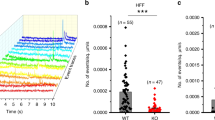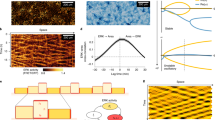Abstract
Directional movement is a property common to all cell types during development and is critical to tissue remodelling and regeneration after damage1,2,3. In migrating cells, calcium has a multifunctional role in directional sensing, cytoskeleton redistribution, traction force generation, and relocation of focal adhesions1,4,5,6,7. Here we visualize high-calcium microdomains (‘calcium flickers’) and their patterned activation in migrating human embryonic lung fibroblasts. Calcium flicker activity is dually coupled to membrane tension (by means of TRPM7, a stretch-activated Ca2+-permeant channel of the transient receptor potential superfamily8) and chemoattractant signal transduction (by means of type 2 inositol-1,4,5-trisphosphate receptors). Interestingly, calcium flickers are most active at the leading lamella of migrating cells, displaying a 4:1 front-to-rear polarization opposite to the global calcium gradient6. When exposed to a platelet-derived growth factor gradient perpendicular to cell movement, asymmetric calcium flicker activity develops across the lamella and promotes the turning of migrating fibroblasts. These findings show how the exquisite spatiotemporal organization of calcium microdomains can orchestrate complex cellular processes such as cell migration.
This is a preview of subscription content, access via your institution
Access options
Subscribe to this journal
Receive 51 print issues and online access
$199.00 per year
only $3.90 per issue
Buy this article
- Purchase on Springer Link
- Instant access to full article PDF
Prices may be subject to local taxes which are calculated during checkout





Similar content being viewed by others
References
Ridley, A. J. et al. Cell migration: integrating signals from front to back. Science 302, 1704–1709 (2003)
Martin, P. & Parkhurst, S. M. Parallels between tissue repair and embryo morphogenesis. Development 131, 3021–3034 (2004)
Werner, S. & Grose, R. Regulation of wound healing by growth factors and cytokines. Physiol. Rev. 83, 835–870 (2003)
Van Haastert, P. J. & Devreotes, P. N. Chemotaxis: signalling the way forward. Nature Rev. Mol. Cell Biol. 5, 626–634 (2004)
Pettit, E. J. & Fay, F. S. Cytosolic free calcium and the cytoskeleton in the control of leukocyte chemotaxis. Physiol. Rev. 78, 949–967 (1998)
Brundage, R. A., Fogarty, K. E., Tuft, R. A. & Fay, F. S. Calcium gradients underlying polarization and chemotaxis of eosinophils. Science 254, 703–706 (1991)
Lee, J., Ishihara, A., Oxford, G., Johnson, B. & Jacobson, K. Regulation of cell movement is mediated by stretch-activated calcium channels. Nature 400, 382–386 (1999)
Nilius, B., Owsianik, G., Voets, T. & Peters, J. A. Transient receptor potential cation channels in disease. Physiol. Rev. 87, 165–217 (2007)
Hahn, K., DeBiasio, R. & Taylor, D. L. Patterns of elevated free calcium and calmodulin activation in living cells. Nature 359, 736–738 (1992)
Stossel, T. P., Fenteany, G. & Hartwig, J. H. Cell surface actin remodeling. J. Cell Sci. 119, 3261–3264 (2006)
Robinson, R. C. et al. Domain movement in gelsolin: a calcium-activated switch. Science 286, 1939–1942 (1999)
Chew, T. L., Wolf, W. A., Gallagher, P. J., Matsumura, F. & Chisholm, R. L. A fluorescent resonant energy transfer-based biosensor reveals transient and regional myosin light chain kinase activation in lamella and cleavage furrows. J. Cell Biol. 156, 543–553 (2002)
Franco, S. J. et al. Calpain-mediated proteolysis of talin regulates adhesion dynamics. Nature Cell Biol. 6, 977–983 (2004)
Evans, J. H. & Falke, J. J. Ca2+ influx is an essential component of the positive-feedback loop that maintains leading-edge structure and activity in macrophages. Proc. Natl Acad. Sci. USA 104, 16176–16181 (2007)
Cheng, H. & Lederer, W. J. Calcium sparks. Physiol. Rev. 88, 1491–1545 (2008)
Hamill, O. P. & McBride, D. W. The pharmacology of mechanogated membrane ion channels. Pharmacol. Rev. 48, 231–252 (1996)
Zou, H., Lifshitz, L. M., Tuft, R. A., Fogarty, K. E. & Singer, J. J. Visualization of Ca2+ entry through single stretch-activated cation channels. Proc. Natl Acad. Sci. USA 99, 6404–6409 (2002)
Numata, T., Shimizu, T. & Okada, Y. TRPM7 is a stretch- and swelling-activated cation channel involved in volume regulation in human epithelial cells. Am. J. Physiol. Cell Physiol. 292, C460–C467 (2007)
Thomas, D. et al. Microscopic properties of elementary Ca2+ release sites in non-excitable cells. Curr. Biol. 10, 8–15 (2000)
Patterson, R. L., Boehning, D. & Snyder, S. H. Inositol 1,4,5-trisphosphate receptors as signal integrators. Annu. Rev. Biochem. 73, 437–465 (2004)
Horwitz, A. R. & Parsons, J. T. Cell migration—movin’ on. Science 286, 1102–1103 (1999)
Pierschbacher, M. D. & Ruoslahti, E. Cell attachment activity of fibronectin can be duplicated by small synthetic fragments of the molecule. Nature 309, 30–33 (1984)
Gomez, T. M., Robles, E., Poo, M. & Spitzer, N. C. Filopodial calcium transients promote substrate-dependent growth cone turning. Science 291, 1983–1987 (2001)
Shu, S., Liu, X. & Korn, E. D. Blebbistatin and blebbistatin-inactivated myosin II inhibit myosin II-independent processes in Dictyostelium. Proc. Natl Acad. Sci. USA 102, 1472–1477 (2005)
Price, L. S. et al. Calcium signaling regulates translocation and activation of Rac. J. Biol. Chem. 278, 39413–39421 (2003)
Weiner, O. D. et al. A PtdInsP3- and Rho GTPase-mediated positive feedback loop regulates neutrophil polarity. Nature Cell Biol. 4, 509–513 (2002)
van Haastert, P. J., Keizer-Gunnink, I. & Kortholt, A. Essential role of PI3-kinase and phospholipase A2 in Dictyostelium discoideum chemotaxis. J. Cell Biol. 177, 809–816 (2007)
Hawkins, P. T. et al. PDGF stimulates an increase in GTP–Rac via activation of phosphoinositide 3-kinase. Curr. Biol. 5, 393–403 (1995)
Claesson-Welsh, L. Platelet-derived growth factor receptor signals. J. Biol. Chem. 269, 32023–32026 (1994)
Ware, M. F., Wells, A. & Lauffenburger, D. A. Epidermal growth factor alters fibroblast migration speed and directional persistence reciprocally and in a matrix-dependent manner. J. Cell Sci. 111, 2423–2432 (1998)
Acknowledgements
We thank I. C. Bruce, X. Zhu, J. J. Ma, H. Q. Cao, J. Liu, M. Zheng, X. D. Fu and R. P. Xiao for discussions, and M. Gorospe, Z. C. Liang, Q. Du, C. M. Cao, H. Huang, X. M. Lan, N. Lin, Y. R. Wang, R. S. Song and Y. Zhang for technical support. Special thanks to X. D. Fu for making his laboratory facility available to us. This work was supported by the Major State Basic Research Development Program of China (2007CB512100), and the National Natural Science Foundation of China (30630021 and 30800371) and an NIH grant (HL090905).
Author information
Authors and Affiliations
Corresponding authors
Supplementary information
Supplementary Information
This file contains Supplementary Methods, Supplementary Figures 1-11 with Legends, Supplementary Tables 1-2 and a Supplementary Reference (PDF 750 kb)
Supplementary Movie
Supplementary Movie 1 shows Calcium flickers occurring in a migrating human embryonic lung fibroblast (WI-38). 30 consecutive Confocal images were compressed to 3.0 second video (10 frames per second). Left panel is DIC transmission part, which shows the motile of a fibroblast. Middle panel is fluo-4 fluorescence part, which shows Calcium flickers occurring during the fibroblast migrating. Right panel is the merged part. (AVI 2628 kb)
Rights and permissions
About this article
Cite this article
Wei, C., Wang, X., Chen, M. et al. Calcium flickers steer cell migration. Nature 457, 901–905 (2009). https://doi.org/10.1038/nature07577
Received:
Accepted:
Published:
Issue Date:
DOI: https://doi.org/10.1038/nature07577
This article is cited by
-
How filopodia respond to calcium in the absence of a calcium-binding structural protein: non-channel functions of TRP
Cell Communication and Signaling (2022)
-
Modification of mesenchymal stem cells by HMGB1 promotes the activity of Cav3.2 T-type calcium channel via PKA/β-catenin/γ-cystathionase pathway
Stem Cell Research & Therapy (2022)
-
PLCγ2 regulates TREM2 signalling and integrin-mediated adhesion and migration of human iPSC-derived macrophages
Scientific Reports (2021)
-
The role of calcium oscillations in the phenotype selection in endothelial cells
Scientific Reports (2021)
-
Studies of anticancer activity in vivo and in vitro behaviors of liposomes encapsulated iridium(III) complex
JBIC Journal of Biological Inorganic Chemistry (2021)
Comments
By submitting a comment you agree to abide by our Terms and Community Guidelines. If you find something abusive or that does not comply with our terms or guidelines please flag it as inappropriate.



